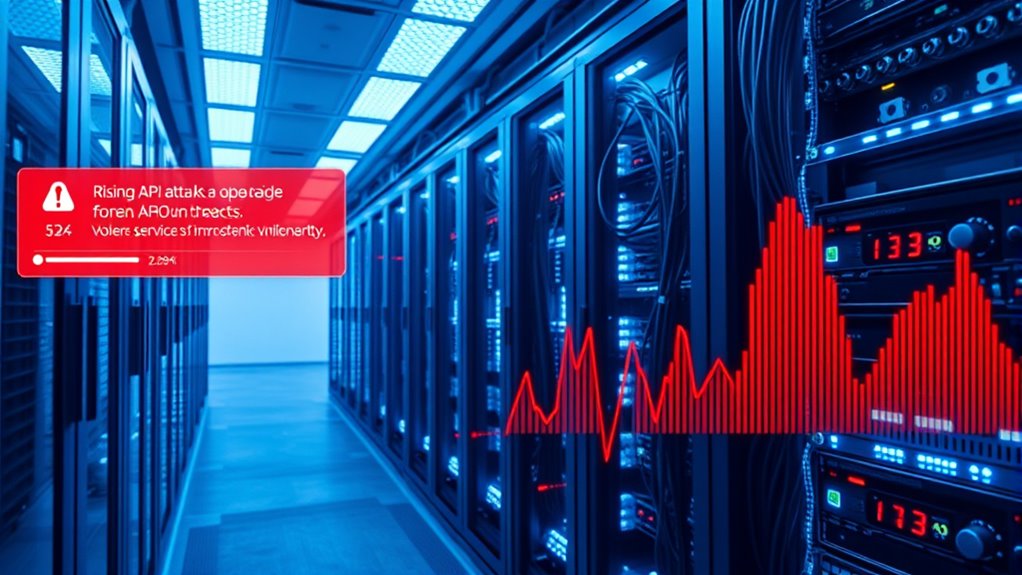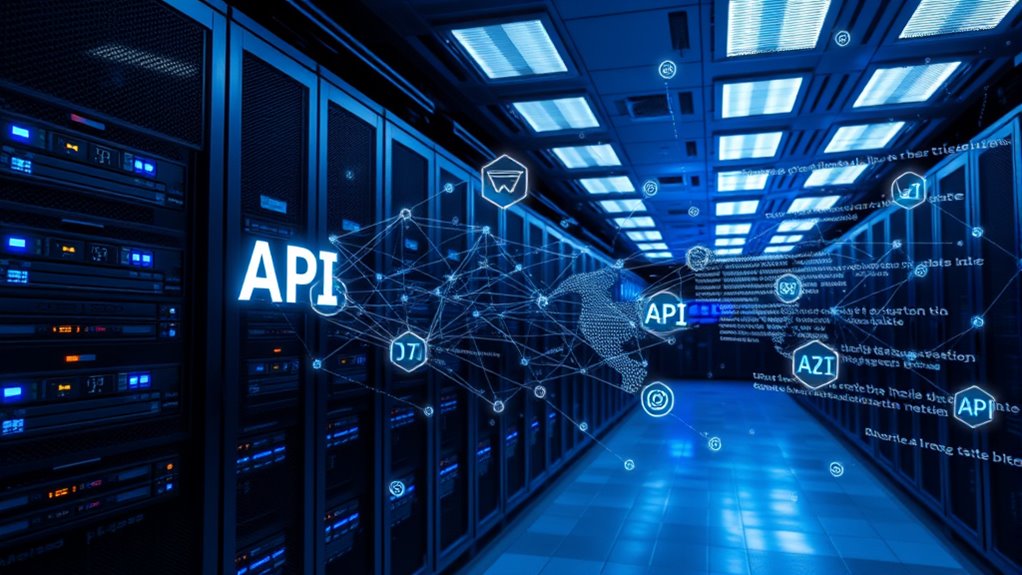As API attacks grow more sophisticated, especially with shadow and zombie APIs, you need to strengthen your microservices defenses. Implement continuous monitoring, centralized visibility, and automated security policies to detect threats in real-time. Use cloud-native API gateways and decentralized gateways to enforce controls across distributed environments. Effective governance and AI-powered threat detection are essential to stay ahead of attackers. Keep exploring to discover more strategies for locking down your microservices against evolving threats.
Key Takeaways
- Shadow APIs, often undocumented, are a primary target for attackers due to their unmanaged and easy entry points.
- AI-powered attacks automate discovery and exploitation of vulnerabilities, increasing the sophistication and scale of threats.
- Implementing distributed API gateways with real-time monitoring enhances security and reduces attack surface.
- Centralized API governance, automated enforcement, and continuous monitoring help detect and respond to attacks swiftly.
- Adopting cloud-native security tools and best practices like least privilege access and secure protocols fortify microservices defenses.
The Growing Threat Landscape for APIs and Microservices

As API traffic surpasses web traffic in 2025, the threat landscape for APIs and microservices has become more dangerous than ever. You face a rising tide of security challenges, with over 90% of web-based attacks now targeting APIs. Unmanaged or shadow APIs, lacking proper oversight, create blind spots that attackers exploit. Modern threats include logic flaws, misconfigured access controls, and vulnerabilities in GraphQL and OpenAPI designs, making attacks harder to detect. Microservices expand your attack surface, introducing more entry points and complexity, especially with serverless architectures and third-party integrations. As threats evolve, relying solely on traditional security measures isn’t enough. You need proactive, AI-driven tools and continuous monitoring to identify anomalies and respond swiftly to emerging risks. Implementing comprehensive data observability allows organizations to gain visibility into API activity, detect suspicious behaviors early, and ensure rapid response to security incidents. Additionally, understanding attack surface management helps organizations minimize exposed vulnerabilities and strengthen their defenses proactively.
Key Challenges in Securing Decentralized Microservice Architectures

Securing decentralized microservice architectures presents unique challenges because their distributed nature increases complexity and expands the attack surface. With multiple services acting as separate network endpoints, you face more entry points for attackers. Monitoring security across all services becomes difficult, as logs and activities are spread out, requiring sophisticated tools to maintain visibility. APIs connecting services are prime targets for injection and data exposure attacks. Containerization introduces risks if images aren’t properly managed, potentially compromising entire systems. Enforcing consistent security policies across autonomous microservices is complicated, especially with limited perimeters and resource management concerns. Implementing effective network segmentation, access control, and service isolation demands careful planning. The increased attack surface makes comprehensive security strategies essential to protect your microservice ecosystem effectively.
Emerging Vulnerabilities: From Shadow APIs to Data Breaches

The rapid expansion of microservices has led to a surge in shadow APIs—undocumented, unmanaged endpoints that fly under the radar of traditional security efforts. In 2022, shadow API searches skyrocketed by 900%, signaling a massive rise in hidden attack surfaces. These APIs are outside IT oversight, making them prime targets due to weak security measures like missing multi-factor authentication and unpatched vulnerabilities. They account for about 31% of malicious API traffic, serving as easy entry points for attackers to access sensitive data and move laterally within networks. High-profile breaches, such as Twitter’s 2021 incident, highlight the real-world risks. Attackers automate discovery and abuse of shadow APIs, escalating threats with increasingly sophisticated tactics, which heighten the risk of data leaks and compliance violations. Incorporating natural materials into security infrastructure, such as organic monitoring tools, can help create a more resilient defense against these emerging threats.
How Sophisticated Attacks Are Evolving With AI and Automation

AI and automation are transforming how attackers target APIs, making threats more advanced and harder to detect. Hackers leverage AI to craft sophisticated exploits and automate attacks, increasing their volume and impact. As defenses struggle to keep up, understanding these evolving techniques is essential to strengthening your security posture. According to recent reports, 70% of organizations are highly or extremely concerned about hackers using AI to develop or improve hacking tools, underscoring the growing threat landscape. Additionally, malicious actors are exploiting home furnishings devices, such as heated mattress pads and mattress toppers, to create new attack vectors and infiltrate networks.
AI-Driven Attack Techniques
As attackers harness AI and automation, their techniques for breaching API security become increasingly sophisticated and relentless. They rapidly scan and map exposed APIs, identifying hidden endpoints more efficiently than ever. AI tools analyze API responses, learning patterns and flagging anomalies for exploitation. Generative AI crafts test payloads and fuzzes endpoints, uncovering logical flaws faster than manual testing. This expanded reconnaissance makes APIs prime targets, with over 70% of web traffic now API-based and organizations averaging 131 third-party APIs. Additionally, understanding cooking techniques can help organizations develop better security practices by analogy, such as marinating and slow-cooking defenses to enhance resilience.
Automation Enhancing Exploits
Automation has revolutionized how attackers deliver and scale exploits against APIs, enabling them to execute complex, high-volume campaigns with minimal manual effort. Automated frameworks quickly probe API endpoints, discovering vulnerabilities and chaining exploits across interconnected services without human intervention. Bots and scripts efficiently perform credential stuffing, scraping, and injection attacks, bypassing defenses like rate limits and CAPTCHAs through intelligent behavior. They target third-party APIs, identifying configuration errors and escalating privileges in complex microservices architectures. Automation also accelerates payload injection into vulnerable endpoints, exploiting flaws in AI and machine learning APIs at scale. With tools that adapt in real-time, attackers can generate new exploits, evade detection, and automate the entire attack lifecycle. Recent studies show that this evolution demands equally advanced, automated defenses to keep pace with these sophisticated threats. Incorporating security best practices into development and deployment processes is essential to mitigate these risks effectively.
Evolving Detection Challenges
The increasing sophistication of API attacks driven by AI and automation challenges traditional detection methods, making it harder to distinguish malicious activity from legitimate user behavior. AI-driven bots can mimic human actions, adapt quickly, and bypass standard security measures, creating a constant arms race for defenders. These attackers exploit shadow and zombie APIs, often going unnoticed and unprotected, while surging bot traffic—up 372% in 2024—targets financial and e-commerce platforms. Traditional defenses like static WAFs struggle to keep up with evolving attack patterns that utilize AI for credential stuffing, data scraping, and evasive maneuvers. To counter these threats, organizations must adopt AI-powered detection tools, runtime monitoring, and cloud-native security solutions that can adapt in real-time, maintaining effective defenses against increasingly intelligent API assaults. Enhanced visibility into API traffic is crucial for early detection and response to these sophisticated threats, especially as adaptive security measures become essential in managing evolving attack vectors.
The Critical Role of AI in Detecting and Preventing API Threats

Artificial intelligence has become an essential tool in defending against API threats, especially as attack methods grow more sophisticated. AI enhances threat detection by 60%, allowing you to identify malicious activity faster and more accurately. It enables real-time responses, reducing detection and resolution times from days to seconds, which is critical against AI-powered bots that surged by 372% in 2024. AI systems quickly adapt to new threats, including emerging AI-generated attacks, while minimizing false positives so your team can focus on genuine issues. AI-driven detection tools also monitor API traffic continuously, catching shadow and zombie APIs that often go unnoticed. Numerous organizations are increasingly adopting AI-driven cybersecurity solutions to stay ahead of evolving threats. By integrating AI into your security strategy, you remarkably strengthen your defenses, ensuring better protection against the expanding and evolving API threat landscape. Additionally, leveraging adaptive security measures allows organizations to stay resilient amidst the rapidly changing cyber threat environment.
Cutting-Edge Solutions for API Security in the Cloud Era

Cloud-native security tools are transforming how you protect APIs, offering scalable and automated defenses tailored for modern environments. Distributed API gateways enable you to enforce granular controls and threat detection at the network edge, reducing blind spots. With AI-driven threat detection, you gain real-time insights that quickly identify and block evolving attacks across your API ecosystem. AI-powered attack detection enhances your ability to anticipate and respond to sophisticated threats before they cause damage. Leveraging comprehensive security strategies ensures that your API infrastructure remains resilient against emerging threats.
Cloud-Native Security Tools
Have you considered how modern API security solutions are evolving to meet the demands of cloud environments? Cloud-native tools seamlessly integrate with development pipelines and container platforms, providing real-time protection and visibility. They support DevSecOps, enabling early vulnerability detection, and include AI-driven threat detection that adapts to user behavior. These tools automate API discovery—even shadow APIs—ensuring comprehensive security. With unified dashboards, managing multiple environments becomes easier. Here’s a quick comparison of key features:
| Feature | Benefit |
|---|---|
| CI/CD Integration | Early vulnerability detection |
| Kubernetes Support | Real-time, container-native protection |
| AI-Powered Threat Detection | Adaptive, continuous security |
| API Discovery & Management | Complete visibility, shadow API control |
| Unified Dashboards | Simplified security management |
These solutions address API sprawl, fragmented management, and security gaps efficiently. API discovery plays a crucial role in identifying all endpoints, including those that are undocumented or hidden, to close security gaps.
Distributed Gateway Advantages
Distributed gateways are transforming API security by decentralizing traffic management and security enforcement. This approach prevents bottlenecks and single points of failure by distributing traffic closer to your microservices, improving load balancing and reducing latency. It also boosts resilience; failures are isolated within individual gateways without impacting the entire system. Localized gateways can independently implement DDoS protections and circuit breakers, strengthening your defenses. They enable seamless failover routing across network zones or clouds, ensuring higher uptime. Additionally, you can enforce consistent security policies—like authentication, rate limiting, and traffic shaping—across all nodes, whether in multi-cloud or hybrid environments. Embedded security features such as WAFs, DLP, and real-time monitoring further enhance protection. This architecture offers operational flexibility, scalability, and cloud independence, empowering your microservices to adapt securely and efficiently. Understanding the security benefits of distributed gateways can help you better mitigate risks associated with API attacks.
AI-Driven Threat Detection
As cyber threats evolve, AI-driven threat detection has become essential for securing APIs in the cloud era. While only 8% of organizations currently use these solutions, most plan to adopt them soon. AI and machine learning analyze API behavior in real-time, detecting anomalies and suspicious activity. However, AI also raises concerns—70% of respondents worry hackers will leverage AI to enhance attacks. AI-powered bots now mimic human behavior, making them harder to identify, and AI’s potential for zero-day attacks increases risk. Key technologies include anomaly detection, machine learning, and API security as code. Implementing continuous validation, real-time monitoring, and AI-driven responses helps defend against sophisticated threats. Staying ahead requires awareness of AI’s dual role in threat detection and attack evolution. Growing API attack surface further complicates security efforts, necessitating advanced AI solutions to stay protected.
Strategies for Effective API Governance and Visibility

Effective API governance and visibility are critical for maintaining security, consistency, and agility across your microservices environment. By establishing a centralized governance framework, you create a single source of truth that streamlines policies and promotes collaboration. Clear policies define roles and responsibilities, ensuring everyone understands their part in maintaining standards. Standardizing API design and security protocols reduces risks and fosters uniformity. Aligning governance with business needs offers flexibility, while all-encompassing technology management keeps your API landscape organized and up-to-date. Visibility is enhanced through well-documented APIs, metadata for discoverability, and consistent communication among stakeholders. Automation tools help enforce governance rules at scale, reducing manual effort and ensuring ongoing compliance. API governance also helps prevent API sprawl by providing clear oversight and structured policies, which is essential for managing large and complex API portfolios. Together, these strategies build a resilient, transparent API ecosystem that supports security and business growth.
Implementing Continuous Monitoring and Automated Defense Mechanisms

Implementing continuous monitoring and automated defense mechanisms is essential for maintaining a secure microservices environment. Real-time monitoring helps you detect threats immediately, while centralized logging consolidates data from all services for efficient analysis. SIEM systems analyze logs to identify suspicious activities, like failed login attempts across multiple services. Advanced tools such as Prometheus, Grafana, ELK, or Splunk give you real-time visibility into API traffic and performance, enabling quick detection of anomalies. Automated alerts notify your team of potential breaches based on predefined security events, allowing swift responses. Automated defense mechanisms like rate limiting, anomaly detection, and IP blocking help you prevent unauthorized access and DDoS attacks. Integrating these systems with incident response plans guarantees coordinated, proactive security that adapts to evolving threats. Implementing these measures ensures a comprehensive security posture that minimizes vulnerabilities and enhances resilience against emerging cyber threats.
Building a Resilient Microservices Security Framework

Building a resilient microservices security framework starts with designing your architecture with security in mind from the outset. Define clear security requirements early so every component is built with protection in mind. Implement least privilege access controls, ensuring each service only accesses what it needs. Use rate limiting and auto-scaling to prevent denial-of-service attacks and maintain availability. Adopt secure coding practices and leverage automated tools for vulnerability detection and remediation. For authentication and authorization, utilize OAuth 2.0 and OIDC, centralize identity management, and enforce fine-grained permissions with short-lived tokens. Secure communication with TLS and mTLS, encrypt data at rest and in transit, and employ API gateways and service meshes. Protect secrets with secure managers, rotate credentials automatically, and keep audit logs to track changes for a thorough, resilient security posture. Implementing security by design ensures that security measures are integrated into every stage of development, reducing vulnerabilities from the start.
Frequently Asked Questions
How Can Organizations Identify Shadow APIS Before They Become Security Risks?
To identify shadow APIs early, you should monitor your network traffic for unexpected API calls and maintain an up-to-date inventory of all authorized APIs. Regular security audits help uncover undocumented endpoints, while API management tools offer real-time visibility. Educate your developers about the risks, and implement centralized governance. These proactive steps help you spot shadow APIs before they pose security threats, keeping your systems safer.
What Role Does AI Play in Automating API Security Incident Responses?
Automating API security incident responses with AI accelerates your attack mitigation. AI detects deviations and anomalies in real time, triggers instant responses like blocking suspicious IPs, and dynamically adjusts rate limits. It actively analyzes behaviors, adapts to evolving threats, and automates containment actions. This swift, smart system reduces response times, minimizes human workload, and maximizes security, ensuring your APIs stay protected against sophisticated, fast-moving cyber threats.
How Can Microservices Be Securely Integrated in Multi-Cloud Environments?
You can securely integrate microservices in multi-cloud environments by implementing consistent security policies across all platforms and using unified identity management. Automate vulnerability detection and enforce strong encryption for data in transit and at rest. Use secure APIs and middleware for seamless communication, and conduct regular security assessments to identify attack paths. Limiting internet exposure and enforcing strict access controls helps minimize risks and guarantees your microservices stay protected across clouds.
What Are the Best Practices for Managing API Sprawl Effectively?
To manage API sprawl effectively, you should establish clear governance policies, enforce design standards, and centralize oversight with an API catalog. Use automated discovery tools to keep inventories up-to-date, and implement API gateways for consistent security and monitoring. Regularly review API usage, deprecate unused endpoints, and monitor traffic for anomalies. This approach helps you maintain control, improve security, and optimize resource allocation across your API ecosystem.
How Do Emerging Threats Like BOLA Influence API Security Strategies?
Emerging threats like BOLA critically impact your API security strategies. You need to implement strict authorization checks for every call, use unpredictable identifiers to prevent manipulation, and validate user roles consistently. Regular penetration testing and keeping your systems updated are essential. By proactively addressing BOLA vulnerabilities, you protect sensitive data, prevent breaches, and guarantee compliance, ultimately strengthening your overall security posture against evolving API threats.
Conclusion
Think of your microservices as a fortress guarding precious treasures. As threats evolve like stealthy invaders, you must reinforce your defenses with smart, automated patrols and vigilant eyes. Embrace AI-powered security as your watchtower, constantly scanning for shadows and breaches. By building a resilient security framework, you turn your fortress into an unbreakable citadel—standing strong against the tide of rising API attacks and safeguarding your kingdom’s most valuable assets.









